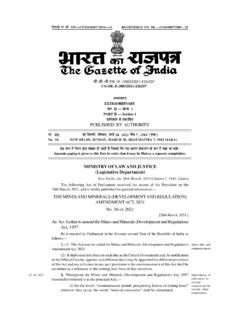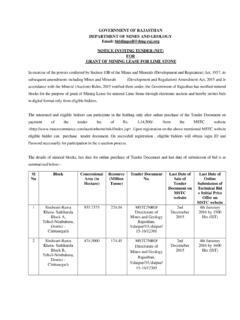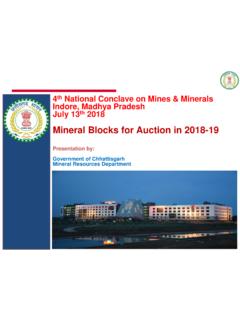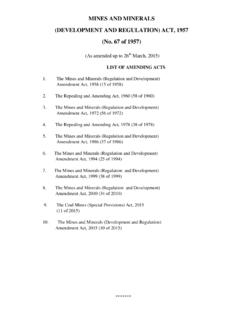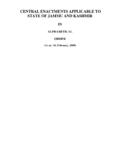Transcription of Exploration and Mining Opportunities in India - …
1 Exploration and Mining Opportunities in IndiaAn Investor GuideBe part of an exciting high growth economyMinistry of mines , Government of IndiaAugust 15, 2015 ContentsAbbreviations ..3 Conversion ..3 1. Introduction to India .. Geography .. Political System .. Economy of India ..5 2. Exploration and Mining in India .. Introduction .. Structure of Minerals and Mining Sector .. Exploration in India .. Mineral Resources/Reserves .. Mineral Production ..9 3. Mineral and Mining Sector Legislation in India .. Overview .. Legislation .. Mineral Administration and Regulation .. Types of Concessions .. Grant of Mining Grant of Composite License .. Grant of Non-exclusive Reconnaissance Permit (NERP) .. National Mineral Exploration Trust (NMET) .. Indicative Clearances ..15 4. Taxation and Royalties .. Overview .. Direct Taxes .. Indirect Taxes .. Mining Levies .. Other Levies .. Incentives ..18 Appendix ..19 Classification of Minerals in India .
2 19 Major Minerals ..20 Geology of Indian Subcontinent ..22 Geological Setting of Peninsular Region ..22 Geology of Extra-peninsular Area ..23 Metallogenic Map of India ..24 Mineral Provinces ..25 State-wise Details of Mineral Belts/ Terrains within the OGP Areas ..25 State-wise and Mineral-wise Details within the OGP Areas ..27 Mineral-wise Reserves and Resources ..28 Information for the Investors ..31 Important Websites and Links ..3231 | Introduction to IndiaAbbreviationsCLComposite LicenseCRIRSCOC ommittee for Mineral Reserves International Reporting StandardsDMFD istrict Mineral FoundationFDIF oreign Direct InvestmentGDPG ross Domestic ProductGSIG eological Survey of IndiaIBMI ndian Bureau of MinesINRI ndian RupeeITIncome TaxkmkilometremmetreMATM inimum Alternate TaxMCDRM ineral Conservation and Development Rules, 1988 MCRM ineral Concession Rules, 1960 MLMining LeaseMMDRM ines and Minerals (Development & Regulation) Act, 1957 MTMillion TonneNERPNon-Exclusive Reconnaissance PermitNGCMN ational Geo-chemical Mapping ProgrammeNGPMN ational Geo-physical Mapping ProgrammeNMETN ational Mineral Exploration TrustOGPO bvious Geological PotentialSEZS pecial Economic Zonesq.
3 KilometresUNFCU nited Nations Framework ClassificationUSDUS millioncrore10 millionExploration and Mining Opportunities in India41 Introduction to GeographyIndia is the seventh largest country in the world by area, with an area of million square kilo metres (sq. km.). The mainland of India extends between latitudes 8 4 and 37 6 north, longi-tudes 68 7 and 97 25 east and measures about 3,214 km from north to south between the ex-treme latitudes and about 2,933 km from east to west between the extreme longitudes. It is bound by the Indian Ocean on the South, the Arabian Sea on the South-West and the Bay of Bengal on the South-East. India shares land borders with Pakistan to the West; China, Nepal and Bhutan to the North-East; and Myanmar and Bangladesh to the East. India has coastline of 7, Political SystemIndia is a federal state organised into 29 states and 7 union territories. India is the world s larg-est democracy governed by the Constitution of India with a bicameral parliamentary form of government.
4 The federal government comprises three branches. Executive the President of India is the Head of the State, while the Prime Minister is the Head of the Government and runs office with the support of the Council of | SnapshotCapitalNew DelhiPopulation1,210 million in million sq. languagesOfficial Language HindiEnglish is used for all official purposesCurrencyIndian Rupee ( ` )Time ZoneIndian Standard Time GMT + 05:30 ReligionHinduism (~80%), Islam (~13%), Christianity, Sikhism, Buddhism, Jainism and Domestic Product (at current prices)USD 2,067 billion in 2014*Gross Domestic Product (at purchase power parity)USD 7,393 billion in 2014*GDP per capita(at current prices)USD 1,631 in 2014*GDP per capita(at purchase power parity)USD 5,833 in 2014*Accounting YearApril 1 to March 31*Source: World Bank Legislative The Indian legislature com-prises the Lok Sabha (House of the People) and the Rajya Sabha (Council of States) forming both the Houses of the Parliament.
5 The Rajya Sabha has a maximum of 250 nominated representatives. The Lok Sabha comprises representatives of people elected every five years through universal adult suf-frage. Maximum strength of the Lok Sabha is 552 members and the current strength of the Lok Sabha is Ship of GSI: Samudra Ratnakar51 | Introduction to India Judicial The Supreme Court of India is the apex body of the Indian legal system followed by the High Courts of respective States and subordinate Economy of IndiaThe Indian Rupee (symbol: `, ISO code: INR) is the official currency of India . The exchange rate of Rupee is market determined and the Reserve Bank of India intervenes as and when required to maintain a stable exchange regime ( man-aged float). As per the World Bank, the GDP of India expanded from USD 834 billion (at current prices) in 2005 to USD 2,067 billion in 2014 (at current prices). Whereas on the basis of pur-chasing power parity, the GDP of India expand-ed from USD 3,274 billion in 2005 to USD 7,393 billion in 2014.
6 During the last decade, India witnessed a consistent growth rate above 6% ex-cept in two years due to various macro-econom-ic sovereign debt is classified as invest-ment grade by the following major credit rating agencies. Standard & Poor s: BBB- (Positive Outlook) Fitch Ratings: BBB- (Stable Outlook) Moody s Ratings: Baa3 (Positive Outlook) and GDP per capita at Current Prices andPurchase Power Parity (2005-2014)GDP CurrentGDP PPPGDP per capitaGDP per capita PPPS ource: World Bank024681012200520062007200820092010201 1201220132014 PercentageAnnaul GDP Growth Rate (2005-2014)GDP Growth RateSource: World BankAnnualExploration and Mining Opportunities in India62 Exploration and Mining in IntroductionDuring the last decade, India had witnessed a consistent high growth above 6% mainly due to rapid urbanization that has increased demand for infrastructure and consumer goods. This de-mand led to more than two fold increase in crude steel production from million tonnes (MT) in 2004 to 81 MT1 in 2013 and demand for metals and minerals in , being the seventh largest country in the world, is well endowed with various miner-al resources.
7 Government of India has recent-ly enacted amendments to mines and Minerals (Development & Regulation) Act, 1957 (MMDR) and notified rules that would help in over-coming many challenges associated with the minerals and Mining sector such as low level mineral Exploration and exploitation, low tech-nology deployment, fragmented and small concession areas etc. India is poised to witness great leaps of growth in minerals and Mining sector with the adoption of transparent and non- discretionary grant of mineral concessions through an auction Structure of Minerals and Mining SectorThe Ministry of mines (MoM), Government of India is responsible for the entire minerals and Mining sector in the country that includes legis-lation, administration, policy formulation etc. in respect of all mines and minerals other than coal and lignite, natural gas and petroleum, but in-cluding offshore minerals.
8 In India , the minerals are classified as minor minerals and major min-erals. The power to frame policy and legislation relating to minor minerals is entirely delegated to the State Governments while policy and leg-islation relating to the major minerals is dealt by the MoM. All the mineral legislations in the coun-try conform to the provisions of the MMDR Act, 1957. MoM through its attached office, Geologi-cal Survey of India (GSI) facilitates Exploration , geological mapping and mineral resource as-sessment in the country. Indian Bureau of mines (IBM), a subordinate office of the MoM is mainly responsible for regulation of Mining in the coun-try. Mineral concessions in India are granted to Indian nationals or entities incorporated in India 1. Source: World Steel Association72 | Exploration and Mining in India only. The entire sector is organised as depicted graphically Exploration in IndiaIndia is a mineral rich country and has favour-able geological milieu which is yet to be fully explored, assessed and exploited.
9 Its geological setup is similar in many ways to that of resource rich countries like Canada, Australia, Brazil, South Africa, Chile and Mexico etc. Exploration activities in India are mostly carried out by GSI, MECL, various State DGMs, public sector un-dertakings (PSU) and private sector entities both domestic and subsidiaries of many global , established in 1851, is the principal agency for geological mapping and regional mineral resource assessment in India . India has a total land area of million sq. km. spread across 5,065 topo sheets and an area of million sq. km. is mappable and GSI has covered million sq. km. ( ) on 1:50,000 scale till March 31, 2013. GSI has identified million sq. km. as Obvious Geological Potential (OGP) area for minerals. A major part of this OGP area is yet to be fully of the Exploration activities in the country are of conventional type with restricted input from geochemistry, geophysics and re-mote sensing.
10 The finds so far, are located near the surface (mostly up to a vertical depth of 100 m). Therefore, with fast depletion of easily ac-cessible and shallow or near surface ore bodies and decline in the rate of locating new mineral deposits within shallow depths, the challenge lies in identifying new area for locating near sur-face deposits and deep seated and concealed/ hidden ore bodies through modern and sophis-ticated Exploration methods/ techniques on the basis of conceptual MineralsMinor MineralsPolicy and LegislationMinistry of mines , GoIState GovernmentRegulationIndian Bureau of MinesDirectorate of Geology & MiningExplorationGSI, MECL & OthersGMDCL, CSMDCL, MPSMCL, OMCL, RSMML, APMDCL and OthersMiningCentralStatePrivateRio Tinto India , De Beers India , SAIL, NALCO, MOIL , Alcoa India , Hindalco Andhra Pradesh Mineral Development Corporation Chhattisgarh State Mineral Development Corporation Gujarat Mineral Development Corporation Government of IndiaMECL Mineral Exploration Corporation MOIL Madhya Pradesh State Mining Corporation National Aluminium Company National Mineral Development Corporation Odisha Mining Corporation Rajasthan State mines & Minerals Steel Authority of India and Mining Opportunities in India8 India has more than 7,500 km.

